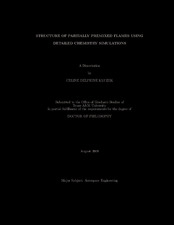| dc.description.abstract | State-of-the-art reacting-flow computations have to compromise either on the detail of chemical reactions or on the dimensionality of the solution, while experiments
in flames are limited by the flow accessibility and provide at best a limited number of observables. In the present work, the partially premixed laminar flame structure is examined using a detailed-chemistry, one-dimensional simulation. The computational results are compared to unpublished single-point multiscalar measurements obtained at Sandia National Labs in 2001. The study is focused on axisymmetric laminar partially-premixed methane/air flames with varying premixture strength values of 1.8, 2.2, and 3.17. The combination of computational and experimental results is
used to analyze the spatial and scalar flame structure under the overarching concept of flamelets. The computations are based on the Cantera open-source software package developed at CalTech by D. Goodwin, and incorporating the GRI 3.0 chemical kinetic mechanism utilizing 325 chemical reactions and 53 species for methane combustion. Cross-transport effects as well as an optically-thin radiation model are included in the calculations. Radiation changes the flame profiles due to its effect on temperature, and the attendant effects on a number of species. Using the detailed analysis of different reaction rates, the adiabatic and radiative nitric oxide concentrations are compared. The cross-transport effects, i.e. Soret and Dufour, were studied in detail. The Soret term has a small but important effect on the flame structure through a reduction of the hydrogen mass fraction, which changes the conserved scalar values.
Based on the flamelet approach and a unique formulation of the conserved scalar, the flame thermochemistry can be analyzed and understood. A number of interesting effects on the flame thermochemistry can be discerned in both experiments and computations when the premixture strength is varied. An increase in premixing results in a counterintuitive decrease in intermediate species such as carbon monoxide and hydrogen, as well as an expected increase in nitric oxide concentrations. Good agreement is found between experiments and calculations in scalar space, while the difference in dimensionality between axisymmetric measurements and opposed jet computations makes comparison in physical space tentative. | en |


